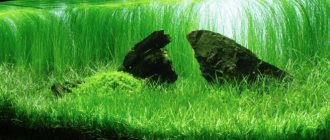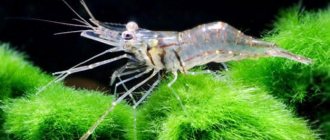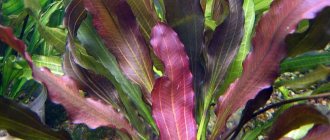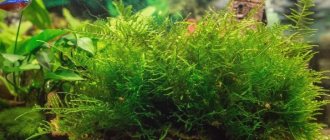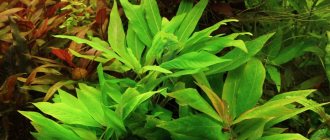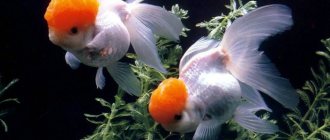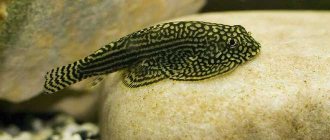Description and features
Echinodorus is native to America. This plant belongs to the Chastukhov family. Reproduction occurs vegetatively and less commonly by the root system. Among Echinodorus, there are both annual and perennial species.
The plant also differs in its external characteristics. Some types of Echinodorus reach a height of more than a meter, while others do not exceed 5 cm. The leaf blades of the plant can also have a variety of shapes and colors. Such a variety of shapes and colors makes it possible to create a magnificent, unique aquarium design.
This plant is conventionally divided into several main groups:
- surface;
- floating;
- underwater.
In terms of care and maintenance conditions, echinodorus are divided into complex and simple. The first group is suitable for experienced aquarists, while simple plant species can be planted by beginners.
Plant characteristics
Echinodorus is characterized by vegetative reproduction.
In nature, representatives of the genus grow in the water column, along the banks of reservoirs, and in wetlands.
Morphological description of the genus Echinodorus:
- The leaves form a dense or loose rosette. The veins are clearly visible on the outer side.
- The flowers are bisexual, 0.7-6 cm in diameter. The corolla consists of 3 petals, painted white, rarely yellow or pink.
- The multi-seeded fruit, 0.5-1 cm in size, breaks into pieces when ripe.
- The underground organs are represented by powerful rhizomes and adventitious roots.
All species of Echinodorus form above-water and underwater forms. They are able to lead a semi-submerged lifestyle, as well as survive on land in drying up water bodies. Plants are most often grown completely submerged. Echinodorus, which grows in the water column, does not bloom and reproduces vegetatively. In some species, vegetative buds are formed in the inflorescences, from which young shoots grow under favorable conditions in a humid environment.
The soil for growing is made up of washed river sand with the addition of clay.
The temperature favorable for echinodorus is +18…+22°C. In aquarium conditions they reproduce vegetatively - by division of rhizomes, suckers, leaf rosettes, and rarely - by seeds. Poor lighting and high acidity of water are unfavorable for growing.
Echinodorus of simple content
This group of plants has the widest popularity, precisely due to its unpretentiousness and high adaptive abilities. Such echinodorus belong to the category of underwater algae and reach a length of 20 cm.
It is recommended to plant the plant with seeds or seedlings. Despite the fact that this group of echinodorus tolerates climate change well, for full growth and development the plant requires bright lighting, periodic filtration and replacement of water, and additional oxygen supply.
Echinodorus can do without fertilizers. But, in order for the plant not to get sick and to please the eye, it is worth periodically using nutrient substrates and other specialized fertilizers. As for lighting, it should be moderate. For illumination, it is recommended to use LED spotlights or fluorescent light bulbs.
Most beautiful
All Echinodorus can be called beautiful plants. But among them there are the most spectacular. As a rule, these are hybrids grown by breeders.
Python
Hybrid of German selection. It is considered one of the most attractive and hardy echinodorus. Even inexperienced aquarists can grow it.
While the bush is young, its leaves are light cherry, with specks. As the plant ages, they become lighter and the speckles become darker. The bush is tall, up to 50 cm, planted singly in the center or in the background.
Regina Hildebrant
The bush is of medium height, with fertilized soil reaches a height of 30 cm. The leaf plate is wavy, burgundy in color. But it only happens in bright light.
Burgundy color is the prerogative of young leaves. With age, they become dark green, and the veins and cuttings become red-brown. The bush was named in honor of the politician Dr. Regina Hildebrant.
Mercedes
A variety of Echinodorus with a stem modified into a rhizome. The leaves are wavy, lanceolate, with a pointed end. They are collected in a beautiful rosette.
Hatched young shoots are colored red. Over time they darken slightly. Old leaves are olive in color. The bush is spreading, up to 25 cm high. Its growth rate is average.
Sine wave
One of the best varieties of Echinodorus. It got its name due to the fact that its sheet plates bend in the shape of a sinusoid graph. Their color is as spectacular as their appearance. It changes as it grows from light cherry shades to darker ones.
The bush is undemanding to lighting. It may be of medium level. It will look beautiful alone in an aquarium, or as a background for low-growing plants.
Pink
This species of Echinodorus is named because it is pink in color when young. With age, it changes green, but there are always up to 5 young shoots on the bush.
Propagated vegetatively, by dividing rhizomes, shoots with daughter bushes. The plant produces inflorescences with many flower whorls. It should be planted in the center of the aquarium at a considerable distance from other bushes.
Maghrebi
This is a bush with a height and diameter of up to 30 cm. Its leaf blade is matte, with a slight gloss and wavy edges that are slightly curled on top. When young it is dark pink in color, then turns brown.
It can be planted anywhere in the aquarium. Its shoots, due to their vertical position, do not create much shade. Therefore, nearby bushes will feel comfortable.
Echinodorus of complex content
This group primarily includes underwater subspecies, characterized by small sizes. Such plants begin to degrade and wither when there is insufficient lighting. In addition, small echinodorus require additional oxygen supply and fertilizer using macro- and micronutrients.
Echinodorus with large and long leaf blades often tend to transform into an emergent form. Therefore, this kind of plant requires regular trimming of the tops. In order for Echinodorus to fully exist under water and not get sick, it also needs moderate nutritious soil and minimized lighting, which are the main growth factors.
Horizontal
One of the most popular varieties of Echinodorus. The plant is characterized by the presence of beautiful decorative leaves that are heart-shaped. The average height of the bush is about 25 cm.
It is recommended to plant horizontal Echinodorus in large aquariums, near the back wall, since the plant develops quickly, forming a spreading bush. Under the right conditions, it grows throughout the whole year.
small-flowered
It is distinguished by its unpretentiousness and large size, reaching up to 40 cm. Therefore, small-flowered echinodorus should be planted in large tropical aquariums filled with warm water. The size and color of the leaf plates largely depend on the lighting.
It is recommended to change the water in the aquarium every week and keep it clean. The best soil for small-flowered echinodorus is nutritious, silty soil.
Amazonian
A beautiful ornamental plant, resistant to numerous unfavorable external factors, for which it has gained wide popularity among aquarists. The length of the bush is about 30-40 cm. The lot plates have a long, narrow shape and a rich, bright green color. The plant develops throughout the whole year.
Yarrow
This variety of Echinodorus is also in great demand. For normal growth and development, the plant needs additional lighting and clean, filtered water. The leaves have an epileptic shape and are quite long.
Echinodorus yarrow belongs to the category of heat-loving plants, but it can withstand hard water well. It is recommended to plant the plant either at the back walls of the aquarium or in the foreground.
Osiris
A spreading bush without a stem, which is a distinctive feature of this subspecies. The plant has oblong leaves collected in a rosette. The color of Osiris leaves varies from green to red-brown, which depends both on the age of the echinodorus and the conditions of its maintenance. For example, with bright lighting, the leaves take on an orange tint.
It has a powerful, creeping root system. The bush reaches its greatest density when planted in nutritious sandy soil.
Small bear
A hybrid plant that has become widespread. It looks like a small in height, but quite dense and spreading bush. The young plant has bright red leaf blades, which darken with age, acquiring a brownish-brown tint.
Argentinian
A large plant, quite finicky in terms of propagation and care. The leaves can have a pear-shaped, rounded, elongated shape, depending on the conditions of keeping this variety of Echinodorus.
Rose
A shrub reaching a height of 30-35 cm. The plant has beautiful leaf plates of light pink color. Requires additional lighting and nutritious muddy soil. It is recommended to plant Echinodorus Rose near the back wall or in the center of the aquarium.
Mottled
An artificially bred hybrid that does not occur in nature. It is distinguished by its compact, small size and wide leaves, giving the shrub an attractive appearance. The castings have the original color and are covered with brownish spots. Speckled Echinodorus is an ideal choice for small to medium sized aquariums.
Mercedes
A variety of Echinodorus that is quite popular among aquarists. It has several small, flexible stems and wide epileptic leaf blades. The average height of the bush is about 30 cm.
The color of the leaves depends on the quality of the soil. For example, in iron-rich soil, the leaves of Echinodorus Mercedes turn a deep purple color. The plant needs nutritious soil and additional bright lighting. Under proper conditions, it blooms several times throughout the year. The plant reproduces vegetatively.
Narrow-leaved
This variety of Echinodorus is noticeably different from others in its external characteristics. The plant has long leaves of bright green color. The average height of the bush is about 45 cm. It is recommended to plant the plant near the back wall of the aquarium. This type of Echinodorus is distinguished by its ease of care and grows throughout the year.
Ruby
A popular plant that is valued by aquarists for its excellent decorative properties and beautiful and bright leaves. This variety of Echinodorus is distinguished by its endurance and good adaptive abilities.
Even in unwashed sandy soil and in low light, the plant feels quite comfortable and continues to grow and reproduce. Platinum leaves are long, narrow, and have a characteristic bright red color, which is why this subspecies got its name - “ruby.”
Vesuvius
A selection variety of Echinodorus, bred relatively recently. But in a short time, Vesuvius became very popular among aquarists. The plant has spectacular spiral-shaped leaves, a rich emerald green color.
Florence
The largest and most powerful species of Echinodorus. The plant has bright red leaf blades that change their color to olive with age.
Florence is quite capricious in his content. For normal growth and development, this plant requires nutritious soil with additional fertilizers, bright lighting for at least 10 hours a day, and an additional supply of carbon dioxide.
Ocelot
A very attractive, variegated plant that can become an excellent decoration for any aquarium. The leaves of this variety of Echinodorus have a unique color with a spotted pattern similar to that of the American ocelot cat.
Aflame
A recently appeared plant, bred by selective breeding and has already won the hearts of aquarists. The plant has very beautiful, slightly wavy leaf blades, rich burgundy color. At the same time, Aflame does not require special attention to itself and careful care.
Porto Alegre
A beautiful and powerful plant reaching 30 cm in height. Characterized by lanceolate leaves, dark yellow in color. For this species of Echinodorus, it is very important to provide a sufficient amount of free space for normal growth and development. Therefore, it is recommended to plant such a plant exclusively in large aquariums.
Porto Alegre is unpretentious to temperature fluctuations and is not demanding on lighting, but it needs clean water, which must be filtered regularly.
Maghrebi
A very attractive aquarium plant with a unique color ranging from green to burgundy tones. Maghribian has small gaps compared to other varieties of Echinodorus, and therefore is perfect even for decorating small aquariums.
Decumbens
A large and spreading shrub, the height of which can reach 50 cm. It has long and narrow green leaf plates directed towards the top. This variety of Echinodorus reproduces using shoots. The plant should be trimmed regularly, since when exposed to air, it begins to bloom with numerous small flowers, while its growth slows down significantly.
Decumbens is not too whimsical in terms of content. All it needs for normal existence is a warm temperature and sufficiently nutritious soil. Adapts well to varying degrees of illumination and water hardness.
Rubra
An elegant plant, suitable even for small containers, since its height does not exceed 15 cm. It is characterized by the presence of small and narrow leaves that have a rich color with variations, even purple tones.
Gentle (or tenellus)
This type of Echinodorus belongs to the category of herbaceous plants. The height of the bush is about 10 cm, so it will be an excellent decoration even for small aquariums.
With all its excellent decorative qualities, the delicate Echinodorus is distinguished by its amazing unpretentiousness in terms of care and high adaptive abilities, for which it has earned such wide distribution and great popularity.
Subalatus
Large shrub with a well-developed massive root system. It has large leaf blades attached to petioles. The color of the leaves is green, and under water and subject to proper maintenance it becomes especially bright and saturated. With sufficient lighting, being in nutritious soil, the subalatus blooms with beautiful white flowers, pleasing to the eye.
But this plant is rarely used for decorating aquariums, due to its too rapid growth and transition to an above-water form. But subalatus will do an excellent job decorating garden ponds, since it is not at all demanding on lighting and tolerates temperature changes well.
Red Diamond
A plant with such an elegant name really looks very impressive and can become an ideal decoration for any aquarium. The shrub has medium height and beautiful sword-shaped leaves. Initially, the leaves are characterized by a rich ruby red color, which darkens over the years, turning into burgundy tones.
Latifolius
Belongs to the category of rosette plants, characterized by compactness and grace. The leaf blades of Latifolius have a rich emerald green color. The height of the bush does not exceed 15 cm. In terms of care, the plant is absolutely picky and tolerates various unfavorable external factors well.
Scarlet Flame
This variety has specific reddish leaves with pronounced brownish veins. The height of the plant is about 25-30 cm. With age, the leaves acquire a uniform green color.
Reiners Felix
It is considered the smallest variety of Echinodorus, since the height of an adult shrub does not exceed 10 cm. Reiners Felix is an excellent option for small indoor aquariums, especially since its decorative properties remain unrivaled.
The oval leaf blades have a spectacular golden color with a pronounced pattern. Over time, the leaves acquire a green color, but at the same time retain their beauty and are pleasing to the eye. The shrub grows slowly and does not require close attention; even a beginner can handle caring for it.
Panamanian
This variety can be planted not only in aquariums, but also insulated greenhouses with sufficient humidity levels. It is characterized by neat oval-shaped leaf blades, slightly pointed upward, green in color with thin veins that form a spectacular pattern. For good growth and prevention of a number of diseases, the Panama Echinodorus requires sufficiently bright lighting, soft water and nutritious soil.
Dark Beauty
This plant was bred by breeders relatively recently, but has already become a favorite among aquarists. Dark Beauty is a small compact shrub, no more than 10 cm long. Its leaves are impressive - bright burgundy in color, gradually darkening and turning into tones that seem almost black under water.
The plant tolerates changes in climatic conditions and water hardness indicators well. But in order for the leaves to retain their rich, bright color, Dark Beauty requires additional lighting.
Muricatus
A relatively tall plant, which, when grown in the air, in a greenhouse can reach a height of up to a meter. It has beautiful oval leaf blades that form a spreading shrub. It is not suitable for decorating aquariums, as it grows quickly and needs regular trimming of the top.
Otherwise, Muricatus is absolutely unpretentious. The only thing that is necessary for its normal development is nutritious soil and a moist, warm environment.
Nazgul
A large selection variety, reaching a height of 50 cm. Young leaves look stunningly impressive, but quickly acquire a uniform green color. However, this plant still has excellent decorative properties, thanks to its graceful stem and crimson color. The plant has an average growth rate and is therefore suitable for growing in large aquariums.
Dancing Fire Feather
A plant with such an unusual name also has a corresponding original, attractive appearance. This variety has large olive leaf blades with an original pattern formed by bright red spots.
The shrub is quite large - its height can reach 70 cm. In order for the plant to please the eye with its bright colors, it needs a sufficient amount of free space, moderate lighting and soft, nutritious soil.
Saint Elmo's Fire
A breeding plant that is famous for its hardiness and unpretentiousness. It continues to actively grow, develop and reproduce even in cool temperatures and low light. Its surface leaf plates, which have an original pink color, are especially well protected.
Bristly
Abundantly flowering, large, showy plant. But at the same time, it is not very suitable for decorating aquariums, due to its height (about 1 m) and intensive growth rate. The bristly echinodorus has original heart-shaped leaves covered with peculiar “bristles” on top. Well suited for decorating garden ponds, but the plant grows only in the warm season.
Uruguayan
Another large variety, the height of which can be more than a meter. The shrub looks very beautiful thanks to the large number of wide leaf blades that have a green or rich red tint. This type of Echinodorus grows evenly and is famous for its good adaptive abilities.
Hildebrandt
A beautiful and compact plant suitable for the design of aquariums of any size. The height of the shrub usually does not exceed 10 cm. This variety of Echinodorus has slightly twisted ovoid leaf blades. The color of the leaves can vary from red to dark purple. When there is insufficient lighting, they darken and fade.
With age, with proper care, the plant retains its attractive appearance. Its leaves look variegated, thanks to a unique combination of green, brown, and red tones. The shrub grows slowly. For full development, the plant requires bright light and nutritious soft soil.
Quadricostatus
It grows quickly and well, forming beautiful, spectacular thickets in the aquarium. The leaf blades of the plant have a delicate light green color, which harmonizes perfectly with the richer shades of other aquarium algae.
Tricolor
A beautiful tricolor plant that delights the eye with its rich colors. This species is quite elegant, the height of an adult shrub is no more than 20 cm. The ribbon-shaped leaves have a wavy edge and a unique color, which is a combination of pale red, golden and green.
Tricolor is valued by users not only for its beauty, but also for its high endurance. This plant is not picky about care; the only thing it needs for healthy growth is soft soil and a sufficient degree of light. Tricolors are an ideal choice for beginner aquarists who are not ready to spend a lot of time caring for ornamental plants.
Python
A wide, spreading shrub, the height of which can be up to 50 cm and the width about 40 cm. The young plant has bright leaf plates of a cherry hue, and over time they turn pale, acquiring a brown color. The python has a moderate growth rate and is quite undemanding in terms of keeping conditions.
Jungle Star
A beautiful, tall shrub, with narrow leaf blades having a linear shape. The leaves are brightly colored, ranging from red to deep purple. The plant is able to survive and develop even in hard water and does not require special attention.
In order for the jungle star not to get sick and maintain its attractive, spectacular appearance, the bush needs nutritious, soft soil and moderate additional lighting.
The most popular varieties
As mentioned earlier, there are many species of Echinodorus. But still, among these aquarium plants there are those that are most beloved by owners of ponds with fish.
Amazonian
This is one of the first species adapted for home ponds. It is unpretentious, easily reproduces, and can withstand changes in water parameters. It grows both in aquariums and paludariums. The root is developed, so the soil is poured to a height of at least 5 cm.
It is a large plant, its height is approximately 40 cm, the leaves are lanceolate. Their color varies from light to dark green. In an aquarium it can grow independently or be a background for smaller bushes. Looks good in containers with a volume of 100 liters or more.
Horizontal
Also very popular among aquarium owners. Its height is 25 cm, light green leaves are heart-shaped. The name was given due to the horizontal arrangement of the shoots relative to the ground.
Loves high water temperatures (about 28 degrees). In spring and autumn, growth slows down, so during this period the temperature drops to 30 -25 degrees. The bush is spreading; it must be kept in a reservoir with a large bottom area, in the middle ground.
Narrow-leaved
This is a shrub with ribbon-shaped bright green leaves up to 60 cm high. It grows quickly, produces mustaches, thanks to which it adapts to various conditions. It easily tolerates temperature fluctuations, but the lighting must be bright, otherwise it loses its beauty.
In an acidic environment, bush growth slows down. Ribbon-shaped Echinodorus in an aquarium will look best in the background, closer to the side wall. They reproduce by numerous tendrils spreading along the ground.
Latifolius
The plant is rare. Its peculiarity is that the leaves under water and above water have different sizes. In an aquarium they are 4–5 cm wide; in a paludarium they increase in volume. The plant is a ground cover and can create a thick carpet in a short period of time. To prevent the latifolius from growing, it must be surrounded with stones.
Loves bright lighting. When weak, the echinondorus begins to stretch. Propagated by underground shoots, used for the foreground. Against its background, Echinodorus sinusoidus, which has curly cherry-colored leaves, will look beautiful.
Blechera (yarrow)
A large species, up to 60 cm high. The leaves are strong, wide, and green. One bush can consist of 30 pieces. The required temperature is 18 - 26 degrees. Propagated vegetatively or by dividing rhizomes.
This bush saturates the water with oxygen, absorbing organic waste from it. It must be placed in large containers, in the middle or background. Shade-tolerant ferns and cryptocorynes will feel good in its shade.
Cordifolia
This is a fast growing bush. Under good conditions, it can quickly grow up to 80 cm. Leaf width is 10 cm, length is 20 cm, the shape at the base is heart-shaped, the edges are wavy.
Tolerates fluctuations in water temperature from 12 to 28 degrees. Prefers bright lighting, lasting up to 10 hours. Rest is required twice a year (30 days). It is located near the back wall of the reservoir, providing a backdrop for low-growing algae.
Schlüter's leopard
It got its name due to the presence of brown spots on the light green leaves. With a lack of nutrition, they become faded. The bush is small in size, maximum height is up to 25 cm. The optimal water temperature range is 22 – 25 cm.
The plant is not tall, so it is placed in front. It does not tolerate oppression, so neighboring bushes should be at a sufficiently large distance from it. It stands out for its spreading rosette and spotted color.
Additional recommendations
In order for Echinodorus to fully develop and not be susceptible to a number of typical diseases, experienced aquarists advise paying attention to the following recommendations:
- Periodic replacement and filtration of water in the aquarium.
- Siphon the soil to avoid rotting of the root system.
- Periodic treatment of roots with birch charcoal.
- Additional lighting for 10 hours a day.
- Additional supply of oxygen and carbon dioxide.
- Fertilizing the soil with basal and root baits.
Following these simple tips will help protect the aquarium plant from putrefactive processes and various diseases, prolong its life and maintain its spectacular appearance.
To prevent the appearance of calcium deposits on the leaf plates, it is recommended to add snails or ancistrus to the aquarium.
Echinodorus coexist well with other aquarium plants that are approximately the same size as them. More spreading growths will shade the Echinodorus, which can negatively affect its growth and external characteristics. If you plant a plant with smaller algae, then the opposite situation is possible, especially if we are talking about light-loving crops.
With bright colors
Many plants attract aquarists due to the bright colors of some species.
Ocelot
This echinodorus can be green, olive, red-brown with terracotta splashes. The plant is large and will require a large container.
It is better to place it in the middle ground. A good background for it will be bushes that form dense thickets behind. It can also be a single planted plant. Its beautiful leaves are good on their own.
Tender (Amazon in miniature)
This is a low-growing species. It requires long-term lighting, up to 12 hours. Otherwise the color becomes faded. In bright light, the bushes become dense, the leaves become ruby
Under ideal conditions, it quickly grows a dense lawn. Echinodorus tender is planted in front of other plants. Used for terrariums, aquariums.
Aflame or Purple Knight
A very impressive plant. The leaves are wavy and their color can vary from bright red to dark purple. Their brightness depends on the lighting. With a lack of nitrogen they become smaller. The bush grows up to 25 cm.
Aflame is planted in the middle of the aquarium. It will highlight the green Echinodorus well. Just as he himself will be a good background for them. In all cases, it will attract attention and create a bright spot.
Red or Red Flame
The bush has large red leaves, on which red-brown blotches are visible. When fluttering, they resemble tongues of flame, hence its name. Grows up to 40 cm.
Echinodorus is adapted to grow in hard water, but its temperature is important. It varies from 22 to 30 degrees. The bush can also be planted in greenhouses. There it will reach a height of 1 m.
Mottled
This echinodorus was bred artificially and is not found in the wild. The bush is compact, low-growing with red-brown spots.
In addition to being kept in a closed container, it can be grown as a garden plant. The bush will feel good when planted in the shallow waters of a pond in the spring and autumn. In the south it can overwinter, but provided that the roots do not freeze.
Black
It was named so for its long and oval dark brown leaves with a notch at the end. This is a fast growing bush. Up to 40 leaves grow from one rosette.
Unpretentious in content. It can grow for a short time in hard, poorly lit water. Under good conditions it grows up to 40 cm, so a large aquarium is chosen.
Barta
One of the amazing plants. Young Echinodorus has dark red leaves, while more mature ones have dark green leaves. The brightness of their color depends on the lighting and the presence of nutrients in the soil.
The lower leaves must be cut off so that they do not block the access of light. The bush takes up a lot of space, so it needs to be planted in a spacious aquarium, closer to the center.
Vesuvius
It is the product of a mutation of Echinodorus angustifolia. It appeared on the market in 2007 and immediately gained popularity. Received its name for its narrow spiral-shaped, emerald leaves, reminiscent of a volcanic eruption.
It is planted in the background of the aquarium and on its sides. Under good conditions, the plant develops an erect peduncle with small white buds.
How to plant
Planting Echinodorus is a simple task that even novice aquarists can handle. There are 2 ways to plant a plant:
- The first is to make a small hole in the ground and plant a small bush in it, pressing it down with decorative stones for better rooting.
- Professionals advise planting Echinodorus in an aquarium with the roots immersed in soil that is already familiar to the plant.
The best soil for this aquarium plant is purified river sand and gravel.
Be sure to add mineral fertilizers to the soil before planting.
Echinodorus is a very beautiful and spectacular aquarium plant that allows you to create a unique design. A huge selection of varieties that differ in size, color, shape, and maintenance conditions allows every aquarist to choose the best option for himself.
Keeping plants in an aquarium
To maintain and grow a bush, a container with a volume of 100-200 liters and a height of 50 cm is required. When planted in an aquarium with smaller parameters, the plant will gradually fill its entire internal space, and the grown leaves will partially rise above the water surface. The appearance of above-water leaves is also possible in a high container at a low water level. To avoid this, you need to control the volume of water and replenish it in a timely manner.
Caring for Echinodorus.
Suitable soil for planting:
- coarse river sand;
- small pebbles or gravel;
- granite chips;
- quartz.
They can be used either individually or in the form of a mixture. The layer should be at least 8 cm thick. Ocelot requires deep planting - this is due to the developed root system of the plant. It should be planted in the central part of the container, away from the walls. The plant is large, with powerful roots, so in crowded conditions it can die. When planting, it is worth considering that the large, strong Ocelot can harm neighboring representatives of the underwater flora. The best option is a single planting or at least at a distance from other plants.
Echinodorus itself is distinguished by its endurance. But for growing it is recommended to create comfortable conditions for it. Optimal water parameters for keeping:
- temperature +20…+27°C (permissible range +18…+30°C);
- hardness (dH) up to 10 mmol/l (permissible range 4-15);
- acidity (pH) 6.4-7.7.
The recommended water change regime is 1/5 of the volume every week. Aeration and filtration are not necessary. Oxygen supply is not necessary, but is helpful. Feeding with mineral fertilizers is not required - the bush has enough nutrients formed naturally in the aquarium environment. But when planting in a new aquarium, where the soil has not yet silted, you need to place a mixture of pieces of clay with charcoal or peat chips under the roots. To accelerate the growth of the bush, it is allowed to use liquid UDO or special balls.
https://youtube.com/watch?v=DkkiDaDoaFo
The optimal lighting brightness for an ocelot is 0.5 W/l. The average recommended daylight hours are 6-12 hours. For illumination, it is better to use fluorescent fluorescent lamps. The plant is shade tolerant. And, unlike other speckled varieties of Echinodorus, it does not lose its spotting even with prolonged shading. But when installing lighting, it is worth considering that with a sufficient amount of light, the cuttings remain short, and if there is not enough light, they stretch upward, which is why the leaves end up on the surface of the water.
Growing
In room:
Echinodorus are grown in aquariums, wet greenhouses and terrariums. For large cultivars with high growth rates, a container of 100–150 liters is needed. Small and slow-growing varieties can be planted in a compact aquarium with a volume of 40 liters or more.
ON VIDEO: Planting the Echinodorus variety 'Ozelot Green' in an aquarium.
Soil requirements differ depending on the variety and variety. Echinodorus uruguayan and Echinodorus cordifolia grow well in poor soil based on washed sand. Less hardy varietal specimens, for example, the H. Barth hybrid 'Rose', need nutritious soil with a high content of humus and clay. Neutral acidity of the soil is desirable.
IN THE PHOTO: Soil-sensitive varietal Echinodorus 'Rose'.
Indoor Echinodorus is kept in water with a temperature of +20–28°C, hardness 4–16°dH and pH 6.8–7.5. To maintain its decorative appearance, the plant needs 8-10 hours of daylight. If there is a lack of sunlight, artificial supplementary lighting is recommended, especially for varieties with variegated colors.
When placed in a terrarium, Echinodorus is watered generously to waterlog the soil in the container. The ground part is constantly moistened by spraying.
Feed weekly, with every water change. Iron-fortified liquid fertilizers are suitable for aquarium plants. It is better to feed terrarium Echinodorus using the root method, described in the article “Using fertilizers for indoor plants.”
In the garden pond:
In late spring and summer, Echinodorus can decorate a garden pond, the water in which has warmed up to +20°C. The air temperature should not fall below +15–18°C at any time of the day.
In regions with a mild coastal climate, where garden ponds do not freeze at any time of the year, it is possible to plant Echinodorus directly into the soil at the bottom.
IN THE PHOTO: Echinodorus cordifolia in an outdoor pond.
Parts of the rhizome are placed in depressions lined with gravel and sprinkled with nutritious silted soil. The soil around the planting is mulched with gravel or pebbles to prevent erosion.
The water in the pond where Echinodorus are located should not stagnate and “bloom.” In addition to the system of inflow and outflow of moisture, such a reservoir is equipped with filtering devices and aeration for the full development of the root system of plants. The arrangement of a pond is described in more detail in the article on garden ponds.
Reproduction and breeding
In addition to their general unpretentiousness in maintenance, speckled corydoras are also distinguished by their ease of reproduction. Spawning often occurs spontaneously, right in a community aquarium. But to obtain maximum offspring, it is best to organize a separate spawning container with a volume of 30 liters or more. It is necessary to place flat stones, driftwood or plants with wide leaves at the bottom of the spawning tank.
Sexual dimorphism is weakly expressed: females are usually larger and have a more saturated body color, the dorsal fin is short and rounded.
A week before spawning, it is best to place the spawners and feed them abundantly. Usually 1 female and 2-3 males are planted in the spawning area. The stimulus for spawning is the addition of fresh cold water. The fish are placed in the aquarium in the evening, and the process itself begins with the first rays of the sun.
The fertilization process is quite unusual. First, the males chase the female, after which she takes milk into her mouth and lays eggs in her folded ventral fins. After this, the female finds a suitable place, lubricates it with milk and glues the eggs. This will increase the percentage of fertilized eggs. The fertility of females can reach 200 eggs.
After spawning, the spawners must be removed. The development of eggs lasts about 5 days. It is best to raise the temperature in the spawning tank to 27-28°C at this time, which will speed up the maturation of the eggs and reduce the risk of them being affected by fungus. The fry of speckled corydoros are quite large, and feeding problems usually do not arise. Small catfish calmly eat tablets for bottom fish. By the age of one month, the size of the fry is about 1 cm. Sexual maturity occurs at the age of 8 months.
Reproduction
Echinodorus major reproduces mainly vegetatively; under artificial conditions, seed propagation is rarely achieved. The plant produces flower shoots several times a year, but almost never produces full-fledged seeds. Artificial pollination using a soft brush slightly increases the chances of success. The fruits are harvested after they are fully ripe. Some experts advise further drying the seeds for 1-2 months. After this, they are sown in a bowl with sand covered with water and kept at a temperature of 28 ° C.
If the fruit does not set on the peduncle, it should be drowned. Then daughter plants will definitely appear on the flower arrow, which can be removed after the formation of 4-5 leaves and a root system. Young plants should be planted in separate bowls, with water only covering the leaves, and placed directly under the illuminator. It is even better to press the entire arrow to the ground near the light source, without separating the daughter plants until a well-formed rosette of leaves 15-18 cm high is formed.
An aquarist who has achieved the flowering of Echinodorus major must take into account that after the formation of a flower arrow, and especially after the appearance of daughter plants on it, the condition of the mother bush worsens. New leaves form very slowly and are much smaller in size. Even complete additional feeding during this period does not help prevent deterioration in the appearance of the plant. Therefore, you should not allow the formation of several flower arrows even in the strongest and largest plants.
Periodically, daughter plants are formed on the rhizome of Echinodorus major. More often this happens with sufficiently bright side lighting. Such shoots develop much better than plants on flower arrows. They can be separated after the formation of an independent root system and the appearance of large leaves. They adapt very well to a new place and quickly begin to grow. The formation of new plants on the rhizome does not inhibit the development of the mother bush.
Description of the genus “Echinodorus (Echinodorus)”
Department Flowering, or Angiosperms (MAGNOLIOPHYTA), or (ANGIOSPERMAE) Family: Chasticaceae (Alismataceae)
It grows in the southern part of North America to South America, as well as on the Greater Antilles. A plant with a shortened stem and a rosette of leaves, a number of species have a rhizome. Planted in nutritious soil.
Lighting: 0.5 W/l.
Water: 22-25°C, dH 5-15°, pH 6.5-7.5.
Propagated depending on the species in the following ways:
- Species that form a flower arrow with an inflorescence and flowers are pollinated with a soft brush. Ripe seeds change color from green to brown. They are separated and some aquarists dry them for 1-2 weeks, after which they are kept for 1.5-2 hours in a vessel with soft water at 25 ° C and its strong circulation to improve seed germination. Then the seeds are planted in a vessel with sand with a low water level at a temperature of 25-28°C; as they germinate, the water level is gradually increased.
- The daughter plants formed on the flower shoot after the formation of roots and 5-7 leaves are separated and planted in the ground. You can tilt the flower arrow with the daughter plant to the ground and press it with a stone so that it takes root.
- Daughter plants formed from adventitious buds on the rhizome, after the formation of roots and 5-7 leaves, can be cut off and planted in the ground.
- V. Yudakov (A-m 3/94) propagates most species starting from the age of 1-1.5 years in the following way. He writes: “The instrument used - a medical lancet or a small knife with a thin blade - must be well sharpened... The mother bush is removed from the aquarium and the roots are straightened, having previously cleared them of soil... The correct cut is easier to make from the roots side, turning the bush over with its leaves facing down. It is necessary to cut so that both the separated and the remaining part of the rhizome have several leaves and roots... After this, the old leaves that weakly adhere to the cut are removed from the plant and planted in its old place.”
- When replanting an old plant with a long rhizome, the rhizome can be cut into pieces and pressed to the ground. Over time, daughter plants are formed from dormant buds.
- Layers formed on a creeping shoot, after the formation of a root system and several leaves, can be separated and planted in the ground. If not separated, over time they will form a lawn.
Other species of the genus:
- Echinodorus palaefolius
- Echinodorus aschersonianus
- Echinodorus bleheri or paniculatus
- Echinodorus horemanii
- Amazonian Echinodorus (Echinodorus amazonicus or brevipedicellatus)
- Echinodorus major or Bart (Echinodorus major or martii)
- Echinodorus verticalis
- Echinodorus horizontally
- Echinodorus latifolius or xingu or magdalenensis
- Echinodorus parviflorus
- Echinodorus tender or grassy Echinodorus (Echinodorus tenellus)
- Echinodorus osiris or Echinodorus rubra
- Echinodorus mucronatum
- Echinodorus sellovianus
- Echinodorus cordifolia (Echinodorus cordifolius or Echinodorus radicans)
- Echinodorus angustifolius
